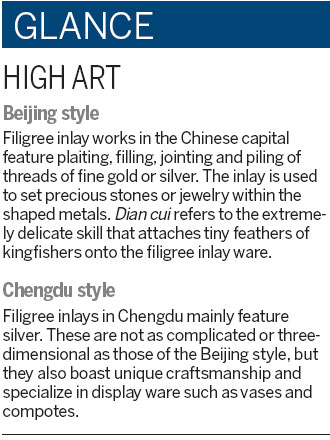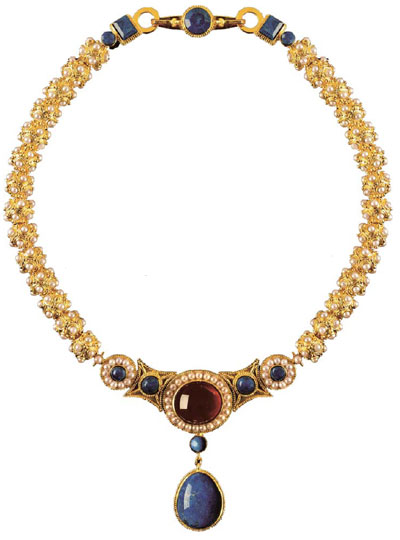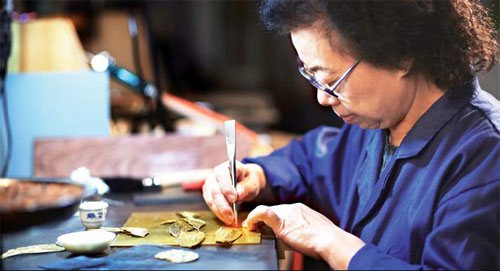In the detail
Updated: 2012-09-14 07:45
By Sun Yuanqing (China Daily)
|
|||||||||||
|
Filigree and inlay regains its former glory as a luxury item in the jewelry business. |
|
Bai Jingyi has been creating filigree and inlay objects of art for 51 years. Photos provided to China Daily |
Intricate Chinese decorative art returns to the fore
Bai Jingyi, 69, has been creating filigree and inlay objects of art for 51 years. But the thought of retiring from the Chinese art form has not crossed her mind.
Bai, who is an official "representative inheritor" of the Chinese decorative metalwork, runs a master's workshop in association with jewelry dealer Zhaoyi Jade in Beijing. She designs, coaches and supervises the works of her apprentices.
"I am never bored. I love the art and enjoy seeing how my students are doing," she says.
Filigree and inlay is a thousand-year-old Chinese royal art that began to fade in the late 20th century. But it is now regaining its former glory as a luxury item in the jewelry business.
This time, it is members of China's growing wealthy who are rediscovering the beauty, history and value behind the craft.
Wang Yunhe, founder and president of Zhaoyi Jade, is particularly ambitious among those who spot the new opportunities behind filigree and inlay.
Zhaoyi is opening a boutique store in Paris next year. The company will also host in Europe a touring exhibition of hundreds of filigree and inlay exhibits that it spent a year making as re-creation of famous works from various Chinese dynasties.
Wang is hopeful that filigree and inlay, as "China's haute couture jewelry", will act as a good companion and carrier for jade, which many say is still not very well recognized in the West.
"The Europeans have a good knowledge of design and handicrafts," Wang says. "The tour and the new store will help them get to know this Chinese traditional handicraft, as well as Chinese culture."
Originating from as early as the Spring and Autumn Period (770-476 BC), the art of filigree and inlay peaked during the Ming (1368-1644) and Qing (1644-1911) dynasties, with top filigree and inlay jewelry reserved for the imperial family.

Beijing, the capital of both the Ming and Qing dynasties, became home to the best filigree artists and historical works. Filigree inlay works in the Chinese capital is a combination of filigree and inlay. Filigree features skills including plaiting, filling, jointing and piling of threads of fine gold or silver. Inlay involves setting precious stones or jewelry within the shaped metalwork.
After the downfall of the Qing Dynasty in 1911, imperial filigree and inlay craftsmen became scattered in and around Beijing and so did their craft. The art became popular among the common people in the 1960s and 1970s, when orders for the State-owned factory flooded in from all over the world, especially from Southeast Asia and Japan, Bai says.
Compared to filigree and inlay art in Central Europe, India and Japan, the Chinese creations are more delicate and complicated, Bai says.
But as the precious metal market opened in the late 1970s and 1980s, the Chinese filigree factory shut down as orders declined amid fierce competition from the private enterprises.
"One of the problems is that the designs didn't cater to the modern customers," Wang says. "The design should always keep up with the times."
Compared to the old styles of filigree and inlay, the designs now tend to be more complicated. It is used more extensively in displays and furniture, which require higher standards of craftsmanship, Bai says.
But the roots of filigree and inlay "still lie in the classics".
"Filigree and inlay is different from jewelry," Bai says. "They can't be exaggerated like fashion jewelry. It's a product of neoclassicism and can only change without affecting its original, royal style."
Zhaoyi opened a boutique shop in the China Central Place, a luxury shopping area in Beijing, offering haute couture jewelry service at prices going into millions of yuan.
Customers can tell the designer what they have in mind. It can take months to create and fulfill a single order.
"We focus on haute couture, not mass production. Like European brands, we look after the quality, not the quantity. We want to present jewelry that is exquisite and rich in history, jewelry that can stand the test of time. It has always been 'Made in China', it's time for 'Created in China'," Wang says.
The demand for filigree and inlay is also rising as more people are turning to classic art after decades of chasing the new and trendy, those in the industry say.
"A young girl can look stunning wearing an old bracelet from her grandmother," Bai says. "You express better with vintage jewelry when everyone else is wearing brand new ones."
With the market for filigree and inlay growing, the challenge is now finding enough craftsmen and artists. The long learning cycle of the craft can be intimidating for young people today, who can be easily tempted by opportunities in other sectors.
"It took three years of hard work for someone to become a filigree craftsman in the old days," Bai says. "This is very hard for young people today. They want to invest less and get more. When they find out that I have been doing this for more than 50 years, they can't understand me. You need absolute devotion to make a career out of it."
However, Bai still managed to recruit dozens of apprentices with her reputation as an accomplished artist. Some of them are recent graduates of jewelry design. Some are craftsmen who have been involved in producing the items for decades and are now learning how to come up with their own designs.
"We have senior masters and young starters, but there is a huge dearth of middle-aged craftsmen," Bai says.
sunyuanqing@chinadaily.com.cn
(China Daily 09/14/2012 page18)
Today's Top News
Rescuers race against time for quake victims
Telecom workers restore links
Coal mine blast kills 18 in Jilin
Intl scholarship puts China on the map
More bird flu patients discharged
Gold loses sheen, but still a safe bet
US 'turns blind eye to human rights'
Telecom workers restore links
Hot Topics
Lunar probe , China growth forecasts, Emission rules get tougher, China seen through 'colored lens', International board,
Editor's Picks

|

|

|

|

|

|







